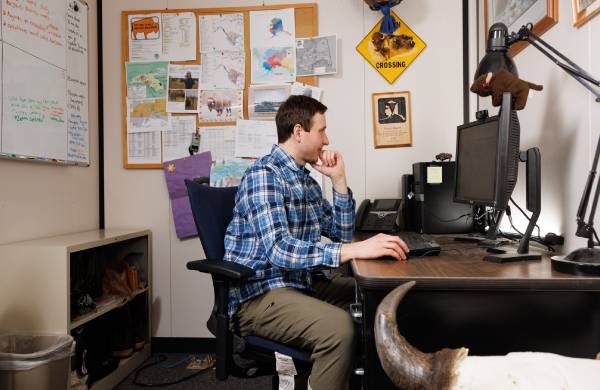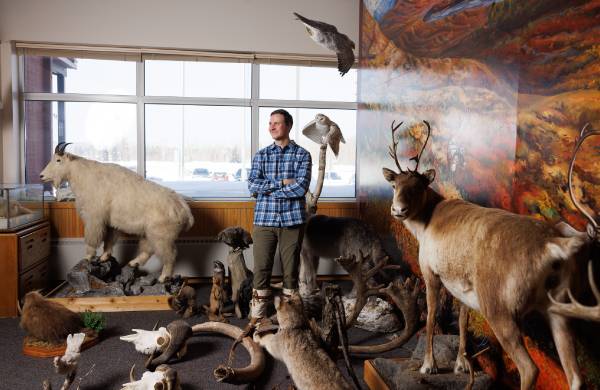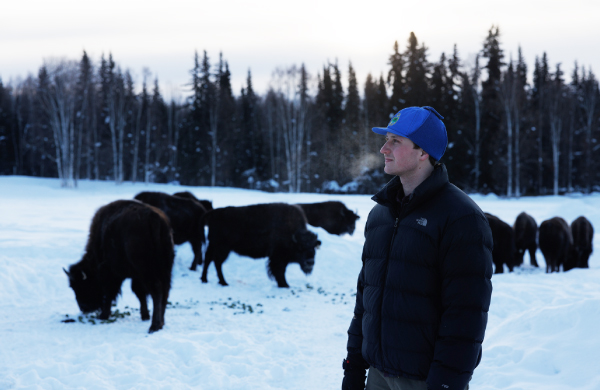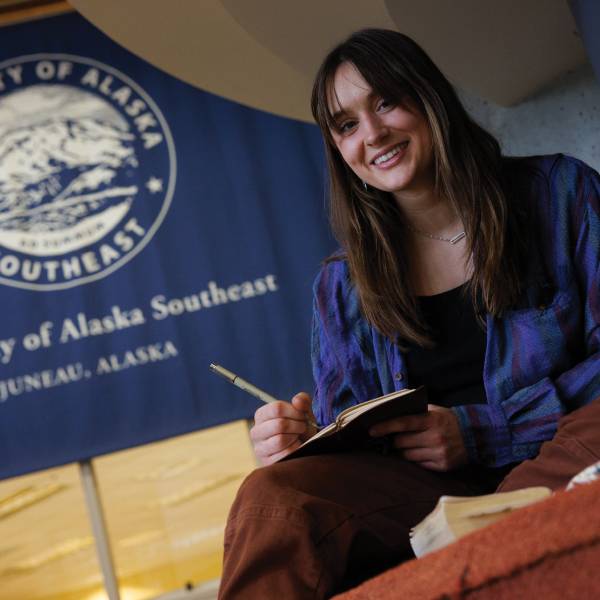Luke Rogers
Preserving an Alaska treasure and a memory.
It’s a typical morning in the field. The cold wind bites as the sun comes up. Hay bales stand at the ready. In the distance, a curious yearling bison pokes his head up, as his grub comes near him.
“Hey buddy,” Luke Rogers says calmly to one of the wood bison he so lovingly cares for. “I’ve got breakfast.”

These magnificent creatures hold a special place in his heart.

During the week, you’ll find Luke at the Large Animal Research Station, a facility that temporarily houses wood bison before release into the wild. There he prepares gear, monitors bison, and enters data as the Assistant Biologist on the Wood Bison Restoration Project with the Alaska Department of Fish and Game. On weekends, he’s in community and organization meetings, sharing his agency’s mission, and inspiring others to join in creating a larger home for wood bison. He’s finding it’s an easy conversation, as they share a mutual passion for these gentle giants, and they have the local know-how there to make it work successfully.
Luke’s true home has always been in the great outdoors. Growing up, his family took week-long rafting trips down wild and scenic rivers in the land of the midnight sun. Come January, the familiar rev of a snow machine could be heard as it carried him and his father, a wildlife planner, into the winter wonderland of the White Mountains. There his dad entertained him with stories of his work passion: a dream of having wood bison back in the Alaska ecosystem again. Luke learned how much they meant to communities and of the nutritious local meat they provide, but he had his sights set on a different path.
Luke was always good at science and a gifted mathematician, so working in nuclear engineering seemed more his speed. He wanted to advance energy production and studying the power of fusion reactors intrigued him. Being an excellent student, he also set his sights high on earning a UA Scholars Award. Awarded to students in the top 10% of their Alaska high school class, he knew it was no small task, but well worth the extra effort. The scholarship would greatly offset the costs of his higher education in Alaska. He was all set. Then something happened that would change everything.



When Luke was just 17, his father passed away from cancer.
Luke took some time off to center himself. After graduating from high school, he traveled through Europe for a few months with his sister. He loved the culture, food and architecture Europe had to offer. Yet throughout it all, he was missing the vast wilderness and large wildlife back home. He wanted to do something more, to help make a bigger impact on Alaska. Later he would find a place that could help make this all possible: the University of Alaska Fairbanks (UAF). It was a familiar and welcoming environment given his parents were students there, and later, his sister would be too.
With the same determination he had growing up, and with scholarship money in hand, Luke got to work learning all he could about science, math, and just for fun, wildlife management. It was a unique combination of courses he could only find at UAF. Yet the wilderness kept calling out to him over his second semester. Then, on the two-year anniversary of his father’s passing, he took part in an event that his dad would’ve loved.
He helped release the first wild wood bison population in the United States after more than 100 years of absence.


From that point on, Luke had found his true passion. It was one he leaned into hard with undergraduate research, volunteer work, and even leaving Alaska to pursue a master’s degree in global bison conservation and train as a future leader in the field. He came back with a mission in mind: to help create a strategy to safely repopulate wood bison herds throughout Alaska. Several could be supported along the Yukon and Tanana River Drainages, each with a healthy, robust population, which would benefit future generations and the survival of our national mammal. Just as nature intended.
Luke knows he’s not alone in this effort. He’ll be the first to tell you that successful restoration requires the support and involvement from local communities, regional population centers, landowners, Alaska Native interests, wildlife conservationists, and state and federal agencies.
As Luke wraps up his day, he looks out over the 28 yearlings and feels a sense of place. Soon, thanks to so many people committed to the program, they may be the founders of a brand-new wild herd. The scene is one he’d like to see play out on a grander scale all over the northern part of the state.
It’s an ending he thinks Alaska, and his father, would enjoy.
“Many have held the baton of wood bison restoration in Alaska over the years, I’m just grateful to be the one holding it currently.” - Luke Rogers
Write your chapter of the Alaska success story. Use your UA Scholars Award to explore
majors at the University of Alaska. Here, real-world experience combines with educational
know-how to start you on your career and benefit everyone who lives here. Learn more
about Wildlife Biology and Conservation and a variety of other majors at UAF’s Academic Programs page. Want to offset your costs even more? Learn about the UA Foundation, Alaska Performance Scholarship and the Alaska 529 Plan.




